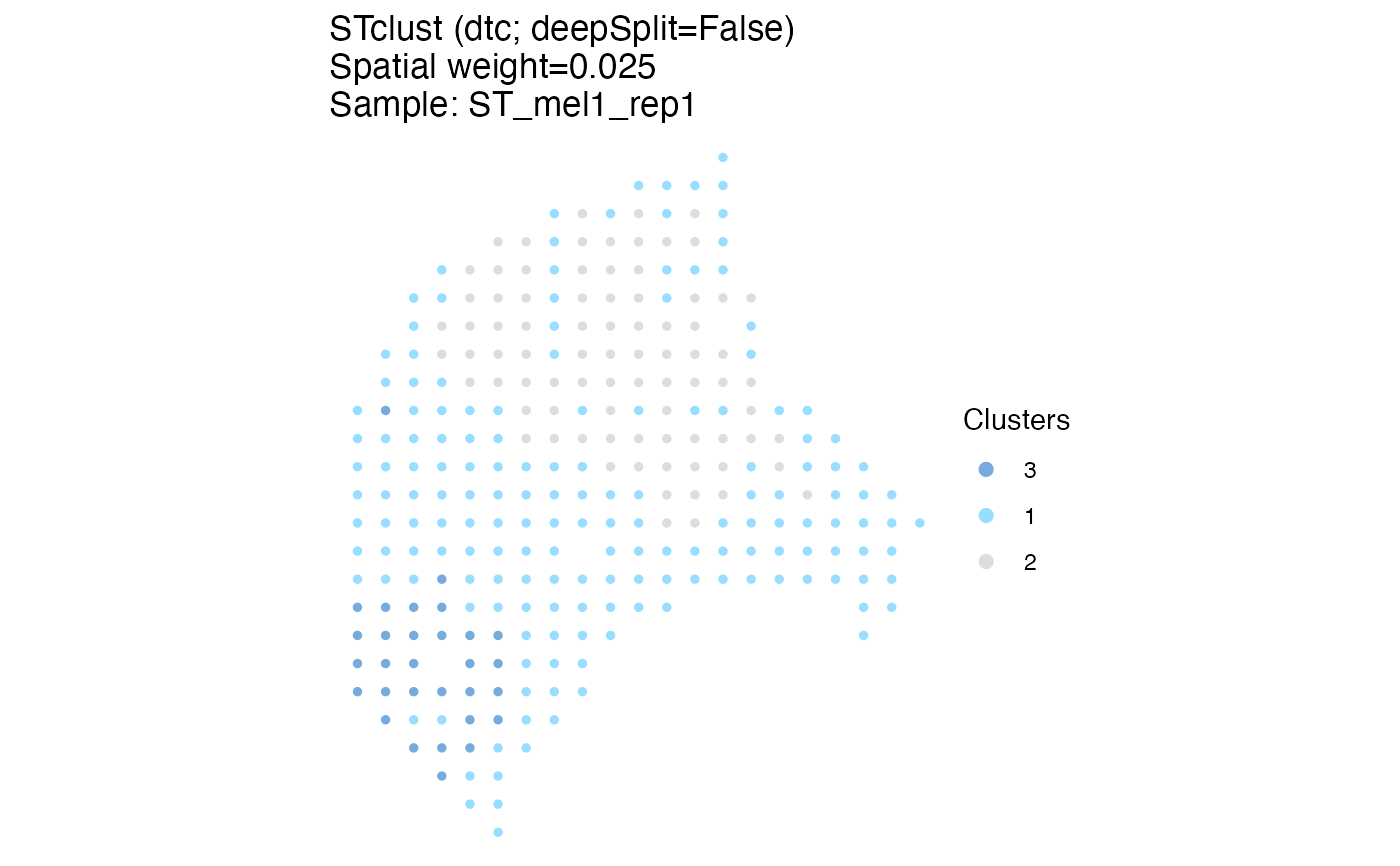STclust: Detect clusters of spots/cells
STclust.RdPerform unsupervised spatially-informed clustering on the spots/cells of a ST sample
STclust(
x = NULL,
samples = NULL,
ws = 0.025,
dist_metric = "euclidean",
linkage = "ward.D2",
ks = "dtc",
topgenes = 2000,
deepSplit = F,
cores = NULL
)Arguments
- x
an STlist with normalized expression data
- samples
a vector with strings or a vector with integers indicating the samples to run STclust
- ws
a double (0-1) indicating the weight to be applied to spatial distances. Defaults to 0.025
- dist_metric
the distance metric to be used. Defaults to 'euclidean'. Other options are the same as in
wordspace::dist.matrix- linkage
the linkage method applied to hierarchical clustering. Passed to
hclustand defaults to 'ward.D'- ks
the range of k values to assess. Defaults to
dtc, meaningcutreeDynamicis applied- topgenes
the number of genes with highest spot-to-spot expression variation. The variance is calculated via
Seurat::FindVariableFeatures.- deepSplit
a logical or integer (1-4), to be passed to
cutreeDynamicand control cluster resolution- cores
an integer indicating the number of cores to use in parallelization (Unix only)
Value
an STlist with cluster assignments
Details
The function takes an STlist and calculates euclidean distances between cells or spots
based on the x,y spatial locations, and the expression of the top variable genes
(Seurat::FindVariableFeatures). The resulting distances are weighted by
applying 1-ws to the gene expression distances and ws to the spatial distances.
Hierarchical clustering is performed on the sum of the weighted distance matrices.
The STclust method allows for identification of tissue niches/domains that are
spatially cohesive.
Examples
# Using included melanoma example (Thrane et al.)
# Download example data set from spatialGE_Data
thrane_tmp = tempdir()
unlink(thrane_tmp, recursive=TRUE)
dir.create(thrane_tmp)
lk='https://github.com/FridleyLab/spatialGE_Data/raw/refs/heads/main/melanoma_thrane.zip?download='
download.file(lk, destfile=paste0(thrane_tmp, '/', 'melanoma_thrane.zip'), mode='wb')
zip_tmp = list.files(thrane_tmp, pattern='melanoma_thrane.zip$', full.names=TRUE)
unzip(zipfile=zip_tmp, exdir=thrane_tmp)
# Generate the file paths to be passed to the STlist function
count_files <- list.files(paste0(thrane_tmp, '/melanoma_thrane'),
full.names=TRUE, pattern='counts')
coord_files <- list.files(paste0(thrane_tmp, '/melanoma_thrane'),
full.names=TRUE, pattern='mapping')
clin_file <- list.files(paste0(thrane_tmp, '/melanoma_thrane'),
full.names=TRUE, pattern='clinical')
# Create STlist
library('spatialGE')
melanoma <- STlist(rnacounts=count_files[c(1,3)], spotcoords=coord_files[c(1,3)], samples=clin_file)
#> Warning: Sample ST_mel2_rep1 was not found among the count/coordinate files.
#> Warning: Sample ST_mel4_rep2 was not found among the count/coordinate files.
#> Found matrix data
#> Matching gene expression and coordinate data...
#> Converting counts to sparse matrices
#> Completed STlist!
melanoma <- transform_data(melanoma, method='log')
melanoma <- STclust(melanoma, ws=c(0, 0.025))
#> STclust started...
#> Updating STlist with results...
#> STclust completed in 0.02 min.
STplot(melanoma, ws=0.025, samples='ST_mel1_rep2', ptsize=1)
#> $ST_mel1_rep2_stclust_spw0.025_dsplFalse
 #>
#>